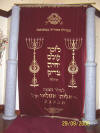|
Bet Eliyahu, Belmonte,
Rosh Hashona 2006 |
|||
 |
 |
||
 |
 |
||
 |
 |
||
 |
 |
 |
|
 |
 |
 |
|
 |
 |
||
|
A Jewish Museum was opened in 2005 consisting of three sections. The first is a collection of personal objects once owned by crypto-Jewish families, some of them very old, loaned by Prof. Adriano Vasco Rodrigues and his wife’s family, the Carquejas. These objects provide an exceptional record of daily life during and after the Inquisition. The second illustrate the Jewish presence in the Belmonte region from the Roman era through the Middle Ages. The third is an enormous black plaque with the full names and ages of victims of the Inquisition from the Belmonte region (see www.cryptojews.com/belmont_museum.htm) Noah Gordon in 'The Last Jew' pp407 on tells the story of a group on their way to Toulouse to escape the Inquisition who discover a 'secret' valley which they hope will enable them to 'hide' from the Inquisition. Something similar is probably how Belmonte came to be founded Belmonte, a town of about 7,500, is located less than 30 miles from the Spanish frontier. A foundation stone has been discovered of a synagogue dated 1297 showing the Jewish community has a long history. In 1917, Samuel Schwartz, a mining engineer, from Galicia, discovered a community of conversos in a remote northern area of Portugal, near the town of Belmonte. They thought they were the only Jews left in the world. and not want to believe Schwarz was a Jew, until he recited the Shema Yisrael and they recognized the name "Adonay."They had succeeded in maintaining their Jewish identity for over four hundred years, marrying mainly among themselves, adhering to the belief in a single personal Deity who would redeem his people at the end of days. They practiced some Jewish observances, the Sabbath and some of the holidays. They would often light candles on Friday night where they could not be seen from the outside. They would observe Passover and Yom Kippur a day or two before or after the date according to the Jewish calendar in order to confuse the agents of the Inquisition. They had preserved a few mourning customs, like the Tahara, the washing of the corpse and the burning of a light during the first seven days of mourning, the Shivah. They performed their own marriage ceremony, by making a declaration in Portuguese which said:
Keeping their existence secret also
affected their diet and names. For example
they made Alheira,
popular heavily seasoned sausages from rabbit and chicken, but gave
the impression that they ate pork and adopted Christian names to
blend into the local population. |